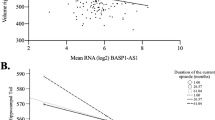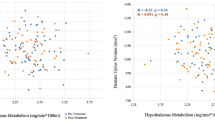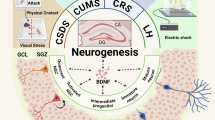Abstract
Smaller hippocampal volume is reported in major depressive disorder (MDD). We hypothesize that it may be related to fewer granule neurons (GN) in the dentate gyrus (DG), a defect possibly reversible with antidepressants. We studied age-, sex-, and postmortem interval-matched groups: no major psychopathology (controls); unmedicated-MDD; and MDD treated with serotonin reuptake inhibitors (MDD*SSRI) or tricyclics (MDD*TCA). Frozen right hippocampi were fixed, sectioned (50 μm), immunostained with neuronal nuclear marker (NeuN), and counterstained with hematoxylin. GN and glial number, and DG and granule cell layer (GCL) volumes were stereologically estimated. Fewer GNs in the anterior DG were present in unmedicated-MDDs compared with controls (p=0.013). Younger age of MDD onset correlated with fewer GNs (p=0.021). Unmedicated-MDDs had fewer mid-DG GNs than MDD*SSRIs (p=0.028) and controls (p=0.032). Anterior GCL glial number did not differ between groups. Anterior/mid GCL volume was smaller in unmedicated-MDDs vs controls (p=0.008) and larger in MDD*SSRIs vs unmedicated-MDDs (p<0.001), MDD*TCAs (p<0.001), and controls (p<0.001). Anterior GCL volume and GN number (r=0.594, p=0.001), and mid DG volume and GN number (r=0.398, p=0.044) were correlated. Anterior DG capillary density correlated with GN number (p=0.027), and with GCL (p=0.024) and DG (r=0.400, p=0.047) volumes. Posterior DG volume and GN number did not differ between groups. Fewer GNs in unmedicated-MDD without fewer neuronal progenitor cells, as previously reported, suggests a cell maturation or survival defect, perhaps related to MDD duration. This may contribute to a smaller hippocampus and is potentially reversed by SSRIs. Postmortem studies are correlative and animal studies are needed to test implied causal relationships.
Similar content being viewed by others
Log in or create a free account to read this content
Gain free access to this article, as well as selected content from this journal and more on nature.com
or
References
Banasr M, Soumier A, Hery M, Mocaer E, Daszuta A (2006). Agomelatine, a new antidepressant, induces regional changes in hippocampal neurogenesis. Biol Psychiatry 59: 1087–1096.
Bannerman DM, Rawlins JN, McHugh SB, Deacon RM, Yee BK, Bast T et al (2004). Regional dissociations within the hippocampus--memory and anxiety. Neurosci Biobehav Rev 28: 273–283.
Boldrini M, Hen R, Underwood MD, Rosoklija GB, Dwork AJ, Mann JJ et al (2012). Hippocampal angiogenesis and progenitor cell proliferation are increased with antidepressant use in major depression. Biol Psychiatry 72: 562–571.
Boldrini M, Underwood MD, Hen R, Rosoklija GB, Dwork AJ, John MJ et al (2009). Antidepressants increase neural progenitor cells in the human hippocampus. Neuropsychopharmacology 34: 2376–2389.
Cavalieri B (1966) Geometria degli indivisibili Reprint of: Cavalieri B (1635) Geometria indivisibilus continuorum. Bononi: Typis Clemetis Feronij Unione Tipografico–Editrice Torinese: Torino, Italy.
Cole J, Costafreda SG, McGuffin P, Fu CH (2011). Hippocampal atrophy in first episode depression: a meta-analysis of magnetic resonance imaging studies. J Affect Disord 134: 483–487.
Deisseroth K, Singla S, Toda H, Monje M, Palmer TD, Malenka RC (2004). Excitation-neurogenesis coupling in adult neural stem/progenitor cells. Neuron 42: 535–552.
Dias BG, Banerjee SB, Duman RS, Vaidya VA (2003). Differential regulation of brain derived neurotrophic factor transcripts by antidepressant treatments in the adult rat brain. Neuropharmacology 45: 553–563.
Eriksson PS, Perfilieva E, Bjork-Eriksson T, Alborn AM, Nordborg C, Peterson DA et al (1998). Neurogenesis in the adult human hippocampus. Nat Med 4: 1313–1317.
Greene J, Banasr M, Lee B, Warner-Schmidt J, Duman RS (2009). Vascular endothelial growth factor signaling is required for the behavioral actions of antidepressant treatment: pharmacological and cellular characterization. Neuropsychopharmacology 34: 2459–2468.
Hsiung SC, Tamir H, Franke TF, Liu KP (2005). Roles of extracellular signal-regulated kinase and Akt signaling in coordinating nuclear transcription factor-kappaB-dependent cell survival after serotonin 1A receptor activation. J Neurochem 95: 1653–1666.
Jin K, Zhu Y, Sun Y, Mao XO, Xie L, Greenberg DA (2002). Vascular endothelial growth factor (VEGF) stimulates neurogenesis in vitro and in vivo. Proc Natl Acad Sci USA 99: 11946–11950.
Kelly TM, Mann JJ (1996). Validity of DSM-III-R diagnosis by psychological autopsy: a comparison with clinician ante-mortem diagnosis. Acta Psychiatr Scand 5: 337–343.
Kempermann G, Kronenberg G (2003). Depressed new neurons—adult hippocampal neurogenesis and a cellular plasticity hypothesis of major depression. Biol Psychiatry 54: 499–503.
Kim H, Li Q, Hempstead BL, Madri JA (2004). Paracrine and autocrine functions of brain-derived neurotrophic factor (BDNF) and nerve growth factor (NGF) in brain-derived endothelial cells. J Biol Chem 279: 33538–33546.
Lee JS, Jang DJ, Lee N, Ko HG, Kim H, Kim YS et al (2009). Induction of neuronal vascular endothelial growth factor expression by cAMP in the dentate gyrus of the hippocampus is required for antidepressant-like behaviors. J Neurosci 29: 8493–8505.
Leuner B, Mendolia-Loffredo S, Kozorovitskiy Y, Samburg D, Gould E, Shors TJ (2004). Learning enhances the survival of new neurons beyond the time when the hippocampus is required for memory. J Neurosci 24: 7477–7481.
Liu S, Wang J, Zhu D, Fu Y, Lukowiak K, Lu YM (2003). Generation of functional inhibitory neurons in the adult rat hippocampus. J Neurosci 23: 732–736.
Mai JK, Paxinos G, Voss T (2008) Atlas of the Human Brain. Academic Press: New York, NY.
Malykhin NV, Carter R, Seres P, Coupland NJ (2010). Structural changes in the hippocampus in major depressive disorder: contributions of disease and treatment. J Psychiatry Neurosci 35: 337–343.
McEwen BS (1999). Stress and hippocampal plasticity. Annu Rev Neurosci 22: 105–122.
McKinnon MC, Yucel K, Nazarov A, MacQueen GM (2009). A meta-analysis examining clinical predictors of hippocampal volume in patients with major depressive disorder. J Psychiatry Neurosci 34: 41–54.
Nettles KW, Pesold C, Goldman MB (2000). Influence of the ventral hippocampal formation on plasma vasopressin, hypothalamic-pituitary-adrenal axis, and behavioral responses to novel acoustic stress. Brain Res 858: 181–190.
Nilsson M, Perfilieva E, Johansson U, Orwar O, Eriksson PS (1999). Enriched environment increases neurogenesis in the adult rat dentate gyrus and improves spatial memory. J Neurobiol 39: 569–578.
Nordanskog P, Dahlstrand U, Larsson MR, Larsson EM, Knutsson L, Johanson A (2010). Increase in hippocampal volume after electroconvulsive therapy in patients with depression: a volumetric magnetic resonance imaging study. J ECT 26: 62–67.
Palmer TD, Willhoite AR, Gage FH (2000). Vascular niche for adult hippocampal neurogenesis. J Comp Neurol 425: 479–494.
Peng CH, Chiou SH, Chen SJ, Chou YC, Ku HH, Cheng CK et al (2008). Neuroprotection by Imipramine against lipopolysaccharide-induced apoptosis in hippocampus-derived neural stem cells mediated by activation of BDNF and the MAPK pathway. Eur Neuropsychopharmacol 18: 128–140.
Pham K, Nacher J, Hof PR, McEwen BS (2003). Repeated restraint stress suppresses neurogenesis and induces biphasic PSA-NCAM expression in the adult rat dentate gyrus. Eur J Neurosci 17: 879–886.
Reif A, Fritzen S, Finger M, Strobel A, Lauer M, Schmitt A et al (2006). Neural stem cell proliferation is decreased in schizophrenia, but not in depression. Mol Psychiatry 11: 514–522.
Risold PY, Swanson LW (1996). Structural evidence for functional domains in the rat hippocampus. Science 272: 1484–1486.
Sahay A, Hen R (2007). Adult hippocampal neurogenesis in depression. Nat Neurosci 10: 1110–1115.
Sairanen M, Lucas G, Ernfors P, Castren M, Castren E (2005). Brain-derived neurotrophic factor and antidepressant drugs have different but coordinated effects on neuronal turnover, proliferation, and survival in the adult dentate gyrus. J Neurosci 25: 1089–1094.
Santarelli L, Saxe M, Gross C, Surget A, Battaglia F, Dulawa S et al (2003). Requirement of Hippocampal neurogenesis for the behavioral effects of antidepressants. Science 301: 805–809.
Sheline YI, Sanghavi M, Mintun MA, Gado MH (1999). Depression duration but not age predicts hippocampal volume loss in medically healthy women with recurrent major depression. J Neurosci 19: 5034–5043.
Sinner B, Friedrich O, Zausig Y, Bein T, Graf BM (2011). Toxic effects of midazolam on differentiating neurons in vitro as a consequence of suppressed neuronal Ca2+-oscillations. Toxicology 290: 96–101.
Strange BA, Dolan RJ (2001). Adaptive anterior hippocampal responses to oddball stimuli. Hippocampus 11: 690–698.
Thierry AM, Gioanni Y, Degenetais E, Glowinski J (2000). Hippocampo-prefrontal cortex pathway: anatomical and electrophysiological characteristics. Hippocampus 10: 411–419.
van Praag H, Kempermann G, Gage FH (1999). Running increases cell proliferation and neurogenesis in the adult mouse dentate gyrus. Nat Neurosci 2: 266–270.
Vollmayr B, Simonis C, Weber S, Gass P, Henn F (2003). Reduced cell proliferation in the dentate gyrus is not correlated with the development of learned helplessness. Biol Psychiatry 54: 1035–1040.
Wang JW, David DJ, Monckton JE, Battaglia F, Hen R (2008). Chronic fluoxetine stimulates maturation and synaptic plasticity of adult-born hippocampal granule cells. J Neurosci 28: 1374–1384.
Wang Z, Neylan TC, Mueller SG, Lenoci M, Truran D, Marmar CR et al (2010). Magnetic resonance imaging of hippocampal subfields in posttraumatic stress disorder. Arch Gen Psychiatry 67: 296–303.
West MJ, Gundersen HJG (1990). Unbiased stereological estimation of the number of neurons in the human hippocampus. J Comp Neurol 296: 1–22.
World Health Organization (2012). Depression: A Global Crisis, World Mental Health Day, October 10, 2012 http://www.wfmh.org/00WorldMentalHealthDay.htm Accessed 26.10.2012.
Acknowledgements
We thank Mihran J Bakalian, BA, for data management and graphics preparation, Tanya H Butt, BS, for immunohistochemistry and stereology work. This study was supported by MH83862, MH94888, MH64168, the American Foundation for Suicide Prevention and the Diane Goldberg Foundation.
Author information
Authors and Affiliations
Corresponding author
Ethics declarations
Competing interests
Maura Boldrini, Adrienne Santiago, Andrew Dwork, Gorazd Rosoklija, Hadassah Tamir, and Victoria Arango declare that, except for income received from their primary employer, no financial support or compensation has been received from any individual or corporate entity over the past three years for research or professional services and there are no personal financial holdings that could be perceived as constituting a potential conflict of interest. Dr Dwork received loans and gifts of equipment and software from Olympus and Visiopharm for research unrelated to this study. Dr René Hen receives compensation as a consultant for Roche and Lundbeck. Dr J John Mann received past unrelated grants from GlaxoSmithKline and Novartis.
Rights and permissions
About this article
Cite this article
Boldrini, M., Santiago, A., Hen, R. et al. Hippocampal Granule Neuron Number and Dentate Gyrus Volume in Antidepressant-Treated and Untreated Major Depression. Neuropsychopharmacol 38, 1068–1077 (2013). https://doi.org/10.1038/npp.2013.5
Received:
Revised:
Accepted:
Published:
Issue date:
DOI: https://doi.org/10.1038/npp.2013.5
Keywords
This article is cited by
-
Current progression in application of extracellular vesicles in central nervous system diseases
European Journal of Medical Research (2024)
-
Cytoprotective effects of Hangekobokuto against corticosterone-induced cell death in HT22 cells
Journal of Natural Medicines (2024)
-
Effects of fluorene-9-bisphenol exposure on anxiety-like and social behavior in mice and protective potential of exogenous melatonin
Environmental Science and Pollution Research (2024)
-
Hypothalamic Gene Expression in a Rat Model of Chronic Unpredictable Mild Stress Treated with Electroacupuncture
Neurochemical Research (2024)
-
Cell type-specific NRBF2 orchestrates autophagic flux and adult hippocampal neurogenesis in chronic stress-induced depression
Cell Discovery (2023)



